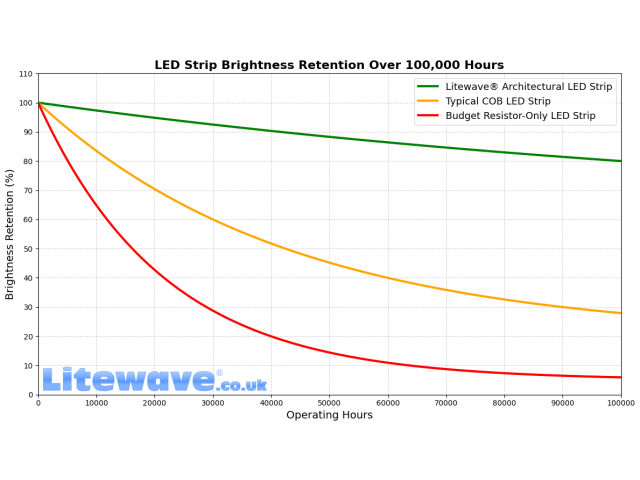The Ultimate Guide to LED Strip Lights for Home — Avoid Early Dimming
Mon, 23 Jun 2025
When selecting LED strip lighting, longevity and brightness retention are critical factors, especially for architectural and commercial applications. Chip-On-Board (COB) LED strips have gained popularity for their smooth, dot-free light. However, many users report noticeable dimming and reduced performance after just 10,000 to 20,000 hours of use.
This article examines why COB LED strips often degrade earlier than expected and how Litewave® Architectural LED Strips are engineered to deliver superior long-term brightness and reliability, without the dreaded dead or dim sections.
Understanding LED Brightness Degradation
LED brightness degradation—also known as lumen depreciation—is a natural process where the light output of an LED declines over time. The industry standard for measuring LED lifespan is the L70 rating, which indicates how many operating hours it takes for the LED to drop to 70% of its original brightness.
-
Under ideal laboratory conditions, LEDs typically maintain good brightness for around 20,000 hours before noticeable degradation.
-
Real-world conditions are often less forgiving: factors like heat buildup, continuous operation, and inadequate current regulation accelerate brightness loss.
Studies, such as one by the Lighting Research Center (2004), confirm that higher junction temperatures—caused by poor heat dissipation—lead to faster degradation.
Why COB LED Strips Dim Earlier Than Expected
Despite their visual appeal, COB LED strips have inherent design trade-offs that reduce their lifespan in practical use:
| Challenge | Impact |
|---|---|
| Heat Concentration | Closely packed LED chips generate more heat, accelerating degradation of the phosphor and semiconductor materials. |
| Material Aging | Silicone encapsulants and phosphor coatings can darken or degrade over time, reducing brightness and shifting color. |
| Simplistic Current Regulation | Many COB strips rely on resistor-based current control, leading to uneven power delivery and increased heat stress. |
| Environmental Exposure | Factors like humidity, dust, and vibration contribute to earlier failures, especially in non-ideal installations. |
Result: While COB strips may promise long lifespans on spec sheets, in practice, many start visibly dimming by 10,000–20,000 hours, with some reaching L70 within that range.
How Litewave® Architectural LED Strips Outperform
Litewave® Architectural LED Strips are specifically engineered to solve the typical LED strip weaknesses:
✅ SMT Transistor Protection: Each LED emitter is paired with a constant current transistor to deliver steady, regulated current. This prevents individual LED burnout and uneven degradation.
✅ Constant Current Drivers: Unlike cheaper resistor-only designs, constant current circuitry stabilizes voltage, reduces temperature spikes, and prevents hot spots.
✅ Enhanced Thermal Design: Superior substrates and thermal materials improve heat dissipation, lowering junction temperatures dramatically.
✅ Verified Performance: Litewave® LED strips retain around 97% of their brightness after 10,000 hours and maintain output well beyond 75,000 hours, backed by a 6-year commercial warranty.
⚙️ Comparison Table: Brightness Retention and Lifespan
| LED Strip Type | Brightness at 10,000 Hours | L70 (70% Brightness) Timeframe | Typical Warranty | Notes |
|---|---|---|---|---|
| Litewave® Architectural | ~97% | 75,000+ hours | 6 years (commercial use) | Constant current transistors, superior thermal control |
| Typical COB LED Strip | 80–90% | 10,000–20,000 hours | 3 years | Susceptible to heat-related degradation |
| Budget Resistor-Only Strip | <70% | 5,000–10,000 hours | 1-2 years | Poor regulation, prone to early burnout |
Conclusion
While COB LED strips offer smooth lighting initially, their practical lifespan often falls short due to heat buildup, material degradation, and inferior electrical design. Litewave® Architectural LED strips, on the other hand, provide reliable, long-term performance through advanced thermal management and constant current technology, offering genuine long-term value for demanding lighting projects.
Link to this article from your website
Link to this article:
Embed article link: (copy HTML code below):



